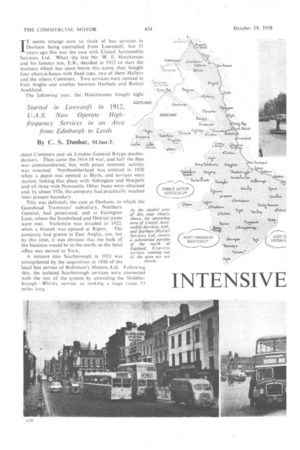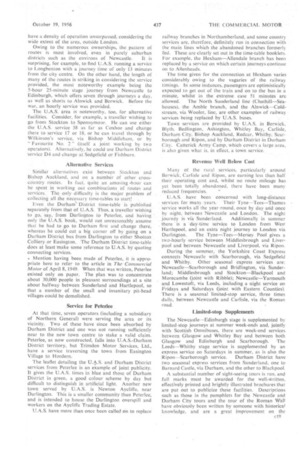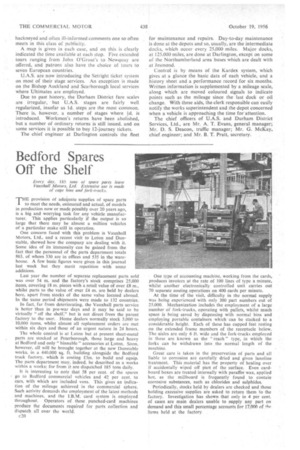INTENSIVE RVICE IN NORTH-EAST
Page 54

Page 55

Page 56

Page 57

Page 58

If you've noticed an error in this article please click here to report it so we can fix it.
IT seems strange now to think of bus services in Durham being controlled from Lowestoft, but 35 years ago this was the case with United Automobile Services, Ltd. When the late Mr. W. E. Hutchinson and his famous son, E.B., decided in 1912 to start the business which has since borne this name, they bought four chars-à-barics with fixed tops, two of them Halleys and the others Commers. Two services were opened in East Anglia and another between Durham and Bishop Auckland.
The following year, the Hutchinsons bought eight more Commers and six London General B-type doubledeckers. Then came the 1914-18 war, and half the fleet was commandeered, but, with peace restored, activity was renewed. Northumberland was entered in 1920 when a depot was opened at Blyth, and services were started, linking that place with Ashington and Morpeth and all three with Newcastle. Other bases were obtained and, by about 1926, the company had practically reached their present boundary.
This was definitely the case at Durham, to which the Gateshead Tramways' subsidiary, Northern General, had penetrated, and at Easington Lane, where the Sunderland and District trams were met. Yorkshire was invaded in 1922, when a branch was opened at Ripon. The company had grown in East Anglia, too, but by this time, it was obvious that the bulk of the business would be in the north, so the head. office was moved to York.
A venture into Scarborough in 1923 was
strengthened by the acquisition in 1926 of the shown.
local bus service of Robinson's Motors, Ltd. Following this, the isolated Scarborough services were connected
with the rest of the system by extending the Middlesbrough—Whitby service, so makinga stage route 53 miles long.
The district superintendent at Scarborough at that time, incidentally, was Mr. H. Bottomley, now general manager of Ribble Motor Services, Ltd. It is appropriate here to pay tribute to " E.B.H.'s " tutoring for, at that time, U.A.S. was a great nursery for future leaders of the industry; the " old boys" list contains the names of many who have since distinguished themselves.
In July, 1929, Tilling and British Automobile Traction, Ltd., and the London and North-Eastern Railway, jointly acquired a controlling interest in U.A.S. and, as a result, several bus undertakings in which the L. and N.E. already had a controlling interest were transferred to U.A.S. In 1942, the Tilling and B.E.T. group rearranged their shareholdings, this element in U.A.S. being replaced by a Tilling Motor Services, Ltd. holding. This led to nationalization in 1948 when the Tilling group was bought by the British Transport Commission, The Carlisle city services were acquired jointly by U.A.S. and Ribble, and the trams replaced by buses, in 1931. In the same year, the East Anglian services were amalgamated with those of the Eastern Counties Road Car Co., Ltd. (Ipswich), Ortona. Motor Co., Ltd. (Cambridge), and Peterborough Traction Co., to form the Eastern Counties Omnibus Co., Ltd.
There was then little point in retaining the head Office at York and, in 1932, it was moved to its present site in Grange Road, Darlington. Another notable event in 1931 was the agreement with Scarborough Corporation for U.A.S. to operate the town's local services, which
was described in detail in The Commercial Motor on June 15.
Longer-distance services originated in 1928 with journeys to Edinburgh, Glasgow and Carlisle. In 1934, a parcels van delivery service was inaugurated. This built up quickly into a general goods service covering most of the north of England, and within two or three years had become linked through the National Conference of Express Carriers with a nation-wide network, by means of its night service between Newcastle, Leeds and Manchester. It eventually formed a useful basis for the organization of the B.R.S. parcels system in the north-east. Parcels are still carried on the buses, as they always have been.
In 1950 the B.T.C. bought Darlington Triumph Motor Services, A.B.C. Motor Services and Express Omnibus Co. (Durham), Ltd. These were amalgamated as Durham District Services, Ltd., and placed under U.A.S. management, but Durham District have a separate legal identity and fleet, a green and cream livery distinguishing the vehicles.
On the U.A.S. joint services with Northern General numbered 42 (Crook—
Newcastle), 46 (Darling t o n — Newcastle), 5 5 (Middlesbrough — Newcastle), 56 (Bishop Auckland—Newcastle), and 57 (Bishop Auckland—Sunderland), Durham is the dividing point, whilst on service 40 (Middles brough—Sunderland) it is Easington Village. On these services, each party keeps its own territorial receipts, and car mileage north and south of the border is balanced periodically.
Similar arrangements exist in respect of the Ripon— Harrogate and Leeds—Whitby services, which are run jointly with West Yorkshire Road Car Co., Ltd., also for the services into Scotland in which U.A.S. are partners with Scottish Omnibuses, Ltd. These services are from Newcastle to Edinburgh, via Berwick, Cold stream and Jedburgh, and from Newcastle and Scar borough to Glasgow_ The intermediate places mentioned are regarded as the border towns.
Durham District are not an "area-agreement company," so that their services run into Sunderland independently, with the restriction that passengers may not be both picked up and set down north of Rainton
Gate 8.8 miles south of Sunderland on the Darlington— Sunderland service via Ferryhill.
U.A.S.'s extensive territory is divided into four areas, each under an area traffic superintendent. They are Northumberland, Durham, Tees-side and Yorkshire, with bases at Newcastle, Durham, Middlesbrough and Scarborough. Although the area superintendents have a considerable measure of responsibility, scheduling of
duties and compilation of time-tables are done at Darlington.
Buses in the U.A.S. fleet, most of them with E.C.W.
bodies. include 520 Bristol single-deckers, the majority e'^
having seats for 35-39 persons. Thirty-one of these have Gardner six-cylindered oil engines, the remainder being fitted with five-cylindered engines of the same make. There are also 185 Bristol 45-seat single-deckers with underfloor engines.
The 202 double-deckers are Bristols. Five of these are Lodekkas, 141 have low-bridge bodies, and the remainder are of high-bridge design. Fifteen Leyland single-deckers complete the bus fleet. Five are Royal Tigers, and the others Tigers with Plaxton sun-saloon bodies for use on the Scarborough summer services.
Bristol coaches are used regularly on the London service, this fleet being augmented in the summer to 26 Bristols and seven Leylands, all with E.C.W. or Harrington bodies. For express services, there are normally 21 Bristol 33-seaters, a further 10 Bristols and 13 Tigers being employed in summer. Bristols with E.C.W. bodies are used an extended and other tours.
In the winter, the Northumberland area is served by 369 vehicles, the distribution being: Alnwick and Seahouses, 26; Ashington, 58; Berwick, 15; Blyth, 47; Carlisle and Alston, 28; Hexham and Allenheads, 21; Morpeth, 23; Newcastle, 110; Rothbury; 6; Whitley Bay, 23; and Wooler, 12.
Durham has 217, Bishop Auckland and Woodlands taking 84; Darlington, 37; Durham, 58; Northallerton, 12; and Richmond, 26. The 233 vehicles allocated to the Tees-side area are stationed at: Loftus (39), Middlesbrough (88), Redcar (45), Stokesley (10), and West Hartlepool (51).
U.A.S. have 89 vehicles in the Yorkshire area. Twenty-four are used on the Scarborough town services, and another 23 based at Scarborough operate the country and Bridlington routes. Pickering also has 6, Ripon and Hawes 25, and Whitby 11.
The Durham District fleet allocation is: Barnard Castle, 4; Darlington, 14; Durham (Gilesgate Moor), 14; Ferryhill, 18; Middlesbrough, 6; and Sunderland 18, a total of 74.
Features of U.A.S.'s operation are the regularity of the headways and the predominance of daily services. In Northumberland, there are a few market-day services, and whilst there are some of this type around Barnard Castle, •Ripon and Northallerton, such operation forms a very small part of the company's activities.
The number of services working on frequencies as low as 10 or 15 minutes (one, at least, every five minutes on Saturdays) is remarkable, especially when one thinks of the number of other operators in the area, many with partly common routes. The result is that south Northumberland and the industrial part of Durham
have a density of operation unsurpassed, considering the wide extent of the area, outside London.
Owing to the numerous ownerships, the pattern of routes is most involved, even in purely suburban districts such as the environs of Newcastle. It is surprising, for example, to find U.A.S. running a service to Longbenton with a journey time of only 13 minutes from the city centre. On the other hand, the length of many of the routes is striking in considering the service provided, the most noteworthy example being the 5-hour 25-minute stage journey from Newcastle to Edinburgh, which offers seven through journeys a day, as well as shorts to Alnwick and Berwick. Before the war, an hourly service was provided.
The U.A.S. area is noteworthy, too, for alternative facilities. Consider, for example, a traveller wishing to go from Stockton to Spennymoor. He can use either the U.A.S. service 38 as far as Coxhoe and change there to service 17 or 18, or he can travel through by Wilkinson's service, via Bishop Middleham, or by " Favourite No. 2 (itself a joint working by two operators). Alternatively, he could Use Durham District service D4 and change at Sedgelleld or Fishburn.
Alternative Services Similar alternatives exist between Stockton and Bishop Auckland, and on a number of other crosscountry routes. in fact, quite an amusing -hour can be spent in working out combinations of routes and serviees. The only difficulty is the major problem of collecting all the necessary time-tables to start!
Even the Durham' District time-table is published separately from that of U.A.S. Thus, a traveller wishing to go, say, from Darlington to Peterlee, and having only the U.A.S. book, would not unreasonably assume that he had to go to Durham first and change there, whereas he could cut a big corner off by going on a Durham District bus from Darlington to either Shotton Colliery or Easington. The Durham District time-table does at least make some reference to U.A.S. by quoting connecting services.
. Mention having been made of Peterlee, it is appropriate here to refer to the article in TheCommercial Motor of April 8, 1949. When that was written, Peterlee existed only on paper. The plan was to concentrate about 30,000 people in pleasant surroundings at a site about halfway between Sunderland and Hartlepool, so that a number of the small and insanitary pit-head villages could be demolished.
Service for Peterlee
At that time, seven operators (including a subsidiary of Northern General) were serving the area or its vicinity. Two of these have since been absorbed by Durham District and one was not running sufficiently near to the new town centre to stake a valid claim. Peterlee, as now constructed, falls into U.A.S.-Durham District territory, but Trirndon Motor Services, Ltd., have a service traversing the town from Easington Village to Hordern.
The leaflet detailing the U1.S. and Durham District services from Peterlee is an example of joint publicity. It gives the U.A.S. times in blue and those of Durham District in green, a good colour scheme by day but difficult to distinguish in artificial light. Another new town served by U.A.S. is Newton Aycliffe, near Darlington. This is a smaller community than Peterlee, and is intended to house the Darlington overspill and workers on the Aycliffe Trading Estate.
U.A.S. have more than once been called on to replace railway branches in Northumberland, and some country services are, therefore, definitely run in connection With the main lines which the abandoned branches formerly fed. These are clearly set out in the time-table booklets. For example, the Hexham—Allendale branch has been replaced by a service on which certain journeys continue on to Alienheads.
The time given for the connection at Hexham varies considerably owing to the vagaries of the railway timings. In some instances, passengers are optimistically expected to get out of the train and on to the bus in a minute, whilst in the extreme case 51 minutes are
allowed. The North Sunderland line' (Chathill—Seahouses). the Amble branch, and the Alnwick—Coldstream, via Wooler, line, are other examples of railway services being replaced by U.A.S. buses.
Town services are provided by U.A.S. in Berwick, Myth. Bedlington, Ashington, Whitley Bay, Carlisle, Durham City, Bishop Auckland, Redcar, Whitby; Scarborough and Ripon, and by Durham District in Durham City. Catterick Army Camp, which covers a large area, is also given what is, in effect, a town service.
Revenue Well Below Cost
Many of the rural services, particularly around Berwick, Carlisle and Ripon, are earning less than half their operating cost and, whilst no route mileage has yet been totally abandoned, there have been many reduced frequencies.
U.A.S. have been concerned with long-distance services for many years. Their Tyne—Tees—Thames service works all the year-round, once by day arid once by night, between Newcastle and London. The night journey is via Sunderland. Additionally in summer there is a day-time service to London from West Hartlepool, and an extra night journey to London via Darlington. The Tyne—Tees—Mersey Pool gives a two-hourly service between Middlesbrough and Liverpool and between Newcastle and Liverpool, via Ripon.
During the summer, the Yorkshire Coast Express connects Newcastle with Scarborough, via Sedgefield and Whitby. Other seasonal express services are: Newcastle--Scarborough and Bridlington, via Sunderland; Middlesbrough and Stockton—Blackpool and Morecambe (joint with Ribble); Newcastle—Yarmouth and Lowestoft, via Leeds, including a night service on Fridays and Saturdays (joint with Eastern Counties). There is a seasonal limited-stop service, three times daily, between Newcastle and Carlisle, via the Roman road.
Limited-stop Supplements
The Newcastle—Edinburgh stage is supplemented by limited-stop journeys at summer week-ends and, jointly with Scottish Omnibuses, there are week-end services between Glasgow and Whitley Bay and between both Glasgow and Edinburgh and Scarborough. The Leeds—Whitby stage service is supplemented by an express service on Saturdays in summer, as is also the Ripon—Scarborough service. Durham District have two seasonal express services from Sunderland, one to Barnard Castle, via Durham, and the other to Blackpool.
A substantial number of sight-seeing tours is run, and full marks must be awarded for the well-Written, effectively printed and brightly illustrated brochures that are put out to publicize these facilities. Descriptions such as those in the pamphlets for the Newcastle and Durham City tours and the tour of the Roman Wall have obviously been written by someone with historical knowledge. and are a great improvement on the
hackneyed and often ill-informed conwnents one so often meets in this class of publicity.
A map is given in each case, and on this is clearly indicated the time available at each stop. Five extended tours ranging from John O'Groat's to Newuuay are offered, and patrons also have the choice of tours to seven European countries.
U.A.S. are now introducing the Setright ticket system on most of their stage services. An exception is made on the Bishop Auckland and Scarborough local services where Ultimates are employed.
Due to past history, the Durham District fare scales are irregular, • but U.A.S. stages are fairly well regularized, insofar as Id. steps are the most common. There is, however, a number of stages where id. is introduced. Workmen's returns have been abolished, but a number of ordinary returns is still issued, and on some services it is possible to buy 12-journey tickets.
The chief engineer at Darlington controls the fleet for maintenance and repairs. Day-to-day maintenance is done at the depots and so, usually, are the intermediate docks, which occur every 25,000 miles. Major docks, at 125,000 miles, are done at Darlington, except on some of the Northumberland area buses which are dealt with at Jesniond.
Control is by means of the Kardex system, which gives at a glance the basic data of each vehicle, and a history sheet and a performance record for six months. Written information is supplemented by a mileage scale, along which are moved coloured signals to indicate points such as the mileage since the last dock or oil change. With these aids, the clerk responsible can easily notify the works superintendent and the depot concerned when a vehicle is approaching the time for attention.
The chief officers of U.A.S. and Durham District Services, Ltd., are Mr. A. T. Evans, general manager; Mr. D. S. Deacon, traffic manager; Mr. G. McKay, chief engineer; and Mr. B. T. Pratt, secretary.












































































































